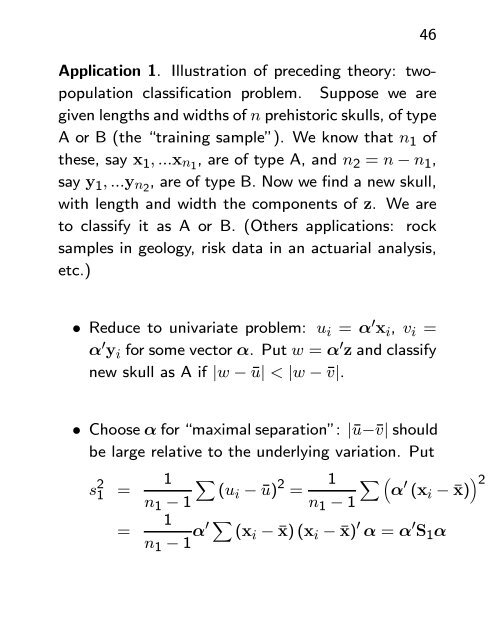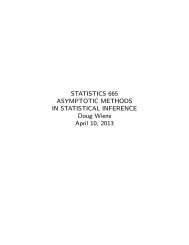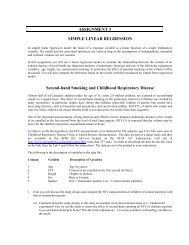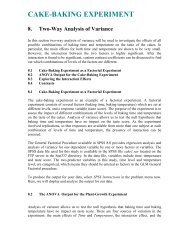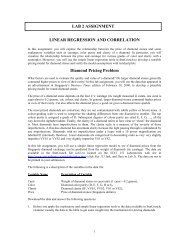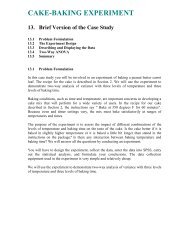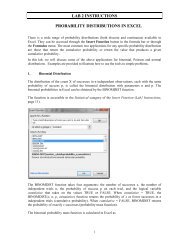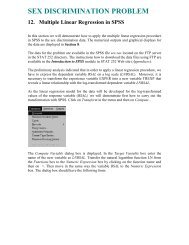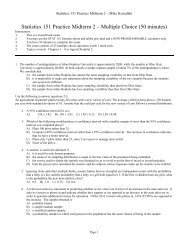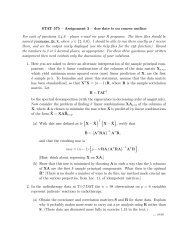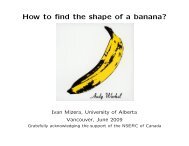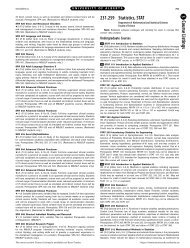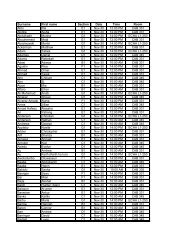- Page 1 and 2: STATISTICS 512 TECHNIQUES OF MATHEM
- Page 3 and 4: II LIMITS, CONTINUITY, DIFFEREN- TI
- Page 5 and 6: 19 Numerical optimization: Steepest
- Page 7 and 8: 7 1. Introduction; matrix manipulat
- Page 9 and 10: - is of rather limited usefulness.
- Page 11 and 12: 11 — Block matrices ... a particu
- Page 13 and 14: 13 for a random matrix X. You shoul
- Page 15 and 16: 15 Here the observations (rows) hav
- Page 17 and 18: 17 3. Identity element: There is 0
- Page 19 and 20: 19 — Fact 1: Every vector space h
- Page 21 and 22: 21 3) Used often: (A 0 A)=(A). Proo
- Page 23 and 24: 23 areallsolvable. Wewrite[b 1 ··
- Page 25 and 26: 25 • Angle between nonzero vecto
- Page 27 and 28: 27 (why?). Geometrically, an orthog
- Page 29 and 30: 29 orthogonal unit vectors q 1 q h
- Page 31 and 32: 31 4. LSEs; Spectral theory • Rec
- Page 33 and 34: 33 (ii) In terms of QR-decompositio
- Page 35 and 36: 35 and = Ã P ⎛ ⎜ ⎝ R S Q !
- Page 37 and 38: 37 • Now suppose that M is symmet
- Page 39 and 40: 39 • Spectral Decomposition Theor
- Page 41 and 42: 41 5. Examples & applications Conse
- Page 43 and 44: 43 This is the ellipsoid in R with
- Page 45: 45 • If H is idempotent then (i)
- Page 49 and 50: 49 Application 2. By the Cauchy-Sch
- Page 51 and 52: 51 6. Limits; continuity; probabili
- Page 53 and 54: 53 — ⊂ R is closed if it cont
- Page 55 and 56: 55 bounded, q say =(0). It can be
- Page 57 and 58: 57 7. Random variables; distributio
- Page 59 and 60: 59 • Since the set = (−∞] is
- Page 61 and 62: 61 • Jensen’s Inequality: If :
- Page 63 and 64: 63 • If → and the function
- Page 65 and 66: 65 • Linearity, product, quotient
- Page 67 and 68: 67 • Taylor’s Theorem:“Suffic
- Page 69 and 70: 69 We want to show that (), which
- Page 71 and 72: 71 9. Applications: transformations
- Page 73 and 74: 73 monotonic. Example: suppose ∼
- Page 75 and 76: 75 Now suppose that → and (ac
- Page 77 and 78: 77 This can make it problematic to
- Page 79 and 80: 79 10. Sequences and series • Con
- Page 81 and 82: 81 Then for each , sup | () − ()
- Page 83 and 84: 83 Thus a convergent sequence (i.e.
- Page 85 and 86: 85 Then for 0 we have 0 = + X
- Page 87 and 88: 87 11. Power series; moment and pro
- Page 89 and 90: 89 • If P ∞ =0 converges fo
- Page 91 and 92: 91 • By (ii), we can repeat the p
- Page 93 and 94: 93 • The moment generating functi
- Page 95 and 96: 95 12. Branching processes • Impo
- Page 97 and 98:
97 Considering the probabilities of
- Page 99 and 100:
99 Since = ( −1 )and is continu
- Page 101 and 102:
101 P(N
- Page 103 and 104:
103 Then clearly () ≤ () ≤
- Page 105 and 106:
105 • Monotonic, bounded function
- Page 107 and 108:
107 • Now define () = Z ()
- Page 109 and 110:
109 • Improper Riemann integrals,
- Page 111 and 112:
111 14. Riemann and Riemann-Stieltj
- Page 113 and 114:
113 • A generalization of the Rie
- Page 115 and 116:
115 • Improper R-S integrals defi
- Page 117 and 118:
117 • Cauchy-Schwarz inequality:
- Page 119 and 120:
119 constant’) ∈ [0 1) as →
- Page 121 and 122:
15. Moment generating functions; Ch
- Page 123 and 124:
123 • Suppose ∼ (0 1), with p.
- Page 125 and 126:
125 • Chebyshev’s Inequality fu
- Page 127 and 128:
127 Let be fixed but arbitrary. Ex
- Page 129 and 130:
129 • Slutsky’s Theorem: If
- Page 131 and 132:
131 Part IV MULTIDIMENSIONAL CALCUL
- Page 133 and 134:
133 • Derivatives. Put e = (00 1
- Page 135 and 136:
135 — If = 1 then the Jacobian m
- Page 137 and 138:
137 1. If the partial derivatives o
- Page 139 and 140:
139 quantile function. Differentiat
- Page 141 and 142:
141 17. Implicit Function Theorem;
- Page 143 and 144:
143 • The Inverse Function Theore
- Page 145 and 146:
145 • Example. Write the characte
- Page 147 and 148:
147 • Often we seek extrema of mu
- Page 149 and 150:
149 under which the satisfaction of
- Page 151 and 152:
151 Since x 2 is a stationary point
- Page 153 and 154:
153 If sup or equivalently if ()
- Page 155 and 156:
155 Here and elsewhere the assumpti
- Page 157 and 158:
157 • Example: Let be independe
- Page 159 and 160:
159 order that 2 () integrate to 1
- Page 161 and 162:
161 Note that x ¯ ¯ = ¯¯¯¯¯
- Page 163 and 164:
163 with = 0 to minimize (by tria
- Page 165 and 166:
165 —Example:solve () =log − 1=
- Page 167 and 168:
167 regression, so I’ll illustrat
- Page 169 and 170:
169 Assuming convergence, the limit
- Page 171 and 172:
171 • For i.i.d. observations wit
- Page 173 and 174:
173 • The MLE is generally obtain
- Page 175 and 176:
175 so that ³ covθ h˙(θ) i =´
- Page 177 and 178:
177 We have (by the WLLN) that X Ã
- Page 179 and 180:
with gradient ˙(θ) = Ã − +
- Page 181 and 182:
181 • Method of moments: Define p
- Page 183 and 184:
• The limit of the NR-process is
- Page 185 and 186:
185 • Now let (X) be any unbiased
- Page 187 and 188:
187 22. Minimax M-estimation I •
- Page 189 and 190:
189 • The asymptotic variance doe
- Page 191 and 192:
191 • We will show that such a pa
- Page 193 and 194:
193 • By the Lemma, () in(22.3)is
- Page 195 and 196:
195 • By comparison with (22.4) w
- Page 197 and 198:
We note that and () = − 0 = −
- Page 199 and 200:
199 • A solution (there are three
- Page 201 and 202:
• The asymptotic normality result
- Page 203 and 204:
203 where the infimum is over all s
- Page 205 and 206:
205 ∪ =1 ;inthiscasedefine R =
- Page 207 and 208:
207 • If is Lebesgue measure the
- Page 209 and 210:
209 • The expected value of a r.v
- Page 211:
211 • It was stated above that if


